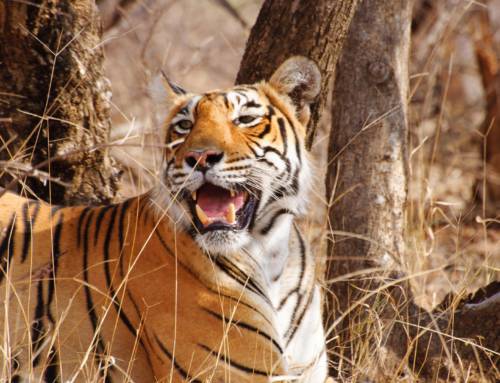Research Article: Divya Vasudev, Robert J. Fletcher Jr. Incorporating movement behavior into conservation prioritization in fragmented landscapes: An example of western hoolock gibbons in Garo Hills, India
Blog Author: Aishwarya Anilkumar
Key takeaways:
- Landscape connectivity is the degree to which landscapes facilitate the movement of organisms between areas of habitat. These connectivity patterns emerge from the interaction between animal movement and the environment.
- Scientists compared the conservation rankings of the fragmented landscape of Garo Hills, Meghalaya, India.
- In the 18 villages surveyed, this pioneering research located a total of 143 fragments. Seven groups of the western hoolock gibbon were observed and studied in Garo.
- As gibbons dwell on trees, their movement involves jumping and swinging between branches using their forelimbs. This movement mode becomes restricted in the relatively open canopy of the modified land cover.
- The study emphasizes the importance of considering constraints caused by the interaction of species-specific traits, like movement, with the environment. Such an approach could provide information essential for understanding, predicting, and prioritizing connectivity.
- The research also highlights incorporating data on movement behavior. Dispersal abilities become especially relevant in habitat fragments interspersed around the human habitat.
- This study indicates that small-scale behavioral observations can provide a vital source of information for connectivity assessments.
Landscape connectivity is one of the prime conservation concerns of the 21st century. Landscape connectivity is the degree to which landscapes actually facilitate or impede the movement of organisms between areas of habitat. A connectivity pattern emerges from the interaction between animal movement and the environment. However, connectivity itself can be ridden with key pressures, such as climate change and habitat fragmentation.
As habitat fragmentation is one of the major threats, conservation should not be restricted to undisturbed habitats. It should rather be focused on heterogeneous landscapes that comprise habitat patches interspersed in a human-modified land cover. Connectivity among habitat patches in a heterogeneous landscape becomes crucial for the species’ persistence and dispersal. Dispersal is an ecological process that involves the movement of individuals away from the population in which they were born, to another location. Organisms that disperse, also called dispersers, are the most vulnerable to fragmentation. Dispersal has traditionally been a challenging behavior to study because of logistical limitations and multiple dynamic variables over time. Despite the increased interest, connectivity assessments often ignore the responses of the dispersers to the matrix type.
The study by Dr. Divya Vasudev and Dr. Robert J. Fletcher compared conservation rankings based on location data and movement constraints of potential conservation areas in a fragmented landscape of forest fragments in Garo Hills, Meghalaya, India. The distance among fragments, habitat use, and movement constraints for the arboreal, western hoolock gibbon (Hoolock hoolock) were determined. Hoolock hoolock is a highly endangered species as these gibbons dwell on trees and their movement involves jumping and swinging between branches using their forelimbs. This species was chosen as their movement mode becomes restricted in the relatively open canopy of the modified land cover. 20 individuals from 7 gibbon groups were observed in the forest fragments of Garo. As these forest fragments were adjoining human settlements, the gibbons were habituated to human presence. The gibbon groups comprised adult males, adult females, and immature individuals. The study located a total of 143 fragments in the 18 villages surveyed. The research assessed the influence of land-cover type on gibbon locations within their home range, for input into connectivity.
The field observations recorded a total of 173 movements from 929 focal scans. Gibbons used jumping and swinging for movement, but there was no record of any instances of descending to the ground. Relative movement probabilities were found to be significantly different in 3 canopy covers (open, closed, and plantations). Movement was found to be highest in the closed canopy followed by plantation and open canopy.
Variations in land cover types of the surrounding habitats influence the movement of many species. The study suggests that by considering the variations and diversity in the habitat patches, conservation solutions could factor in these new and unique insights. The study emphasizes the importance of considering constraints caused by the interaction of species-specific traits like movement behavior with the environment. Such an approach could provide rudiments for understanding, predicting, and prioritizing connectivity.
This study shows that small-scale behavioral observations can provide a crucial source of information for connectivity assessments. The scientists conclude that identifying and assessing the movement constraints can form a vital source of information for describing land uses. It proves especially valuable in heterogeneous landscapes in terms of their benefit to species persistence. In doing so, incorporating such information could aid in prioritizing conservation units, and directing conservation strategies. This could contribute to appropriate and applicable land-use planning. Initiatives like these directly improve the efficiency of species conservation in the land that is shared by humans and wildlife. A humble maneuver could lead to a hopeful outcome and give the gibbons of the Garo Hills their own space to sway.
You can access the original article here.
Keywords: Landscape connectivity, dispersal, movement behavior, habitat fragmentation, land-use planning, conservation, hoolock gibbon.





